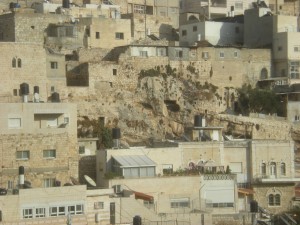
This past Friday’s class focused mainly on Biblical Jerusalem. By exploring its history both through the archaeology and through the Biblical texts, we were able to formulate a picture of what makes this small piece of real estate so important in the context of world history. I’m sure I’ll have more to add once we actually take our tiyul around the area of Ir David / “The City of David.” But I did want to discuss a few interesting points that came up.
Firstly, I was not aware that Jerusalem is associated with the biblical city of Shalem (Salem), mentioned in Genesis Chapter 14. But apparently Kind David made this connection in Psalms 76:3 by writing, “In Salem also is set His tabernacle, and His dwelling-place in Zion.”
Why is this significant? Well for one thing it made me realize something that completely altered an image I’d had forever in my mind (and which I suspect most people share). The meeting between Abraham and Malchizedek outside Salem predated the Akeidah / Binding of Isaac. By most opinions, that latter event (the Akeidah) took place on top of the Temple Mount. Which would mean that the Binding of Isaac actually took place a mere few minutes’ walk from a large (for the time) city. And a significant one at that.
I don’t know about you, but I always pictured the Binding taking place out in the middle of the wilderness somewhere. In a secluded, forested area, perhaps. But this points to a different image — one in which Abraham had to pass this difficult test within shouting distance of a major town of the time. Which, of course, shows how much more difficult his test was. If he had done this in the wilderness somewhere, not everyone would know what he did. But here he was being asked to perform an act out of faith that seemed diametrically opposed to all he had been preaching, and to do it in a place where people would likely be able to see him. Or at least where they might be able to figure out what he’d done. Puts a whole different spin on things, doesn’t it?
What else? We learned how Jerusalem was a very strongly fortified city for most of the period straight through from the time of Abraham, through to David’s time. Support for this comes from many sources. Firstly, the Egyptian Execration Texts list a number of cities from ancient Canaan, but the only one in the first series that is not along the important Via Maris was Jerusalem. (The second series also included Shechem.)
Also interestingly, when Joshua led the Jews in conquering the land, they first took Jericho and then Ai. Following this, the king of Jerusalem formed an alliance and fought the Israelites, but Joshua defeated him and his army (that story with the sun standing still). And yet, despite killing the king of Jerusalem, and destroying its army, he still did not conquer the city of itself! By the time of David, it is a lone Jebusite stronghold in the middle of Israelite territory. Thus, he must take it and make it his capital.
Lastly, we discussed how the archaeology at the City of David indicates a few amazing things. For one thing, the walls that surrounded the city, probably built by king Hezekiah, are built atop the ruins of walls that date back to the Middle Bronze II era — the time of Malchizedek. In other words, the walls that were around the city in Abraham’s time, were probably the same walls that stood all the way through to when David conquered the city! That’s a pretty solid fortification.
By the way, I will not be joining my class on their siyur (tour) tomorrow due to a prior commitment, so you won’t see any reports from me on it. I hope to make it up down the road.
